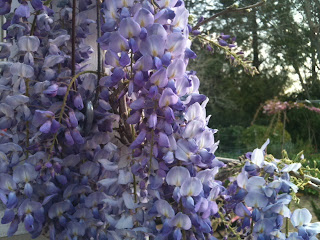
Not quite the latest triumph in Magic Garden; as Spring is waving her magic wand in every corner - but certainly one I feel very proud now to claim as my own. When we first moved in, this wisteria had been languishing under the Hills Hoist, trapped and somewhat stunted. It wasn't flourishing and seemed to not have the even the energy required to colonise the hoist. As creating my kitchen garden beneath was my first priority, this lovely lady needed a new home. Hedging my bets, and loving the idea of an ugly garage transformed, I trimmed her root ball and placed her, well fertilised in a half-wine barrel. Then I got busy with the secateurs, the sugar cane mulch and proceeded to drown her with water. And a year later, I realised, that the soil mix was far too heavy with clay and I'd compounded the drainage issues with too. much. mulch. This was when I first came to understand the depths of my mulch addiction.
Fast forward, 2 years later: I am pleased, actually ecstatic to report that my attempts at rehabilitation (mark 2) have been a resounding success and I offer the following images as a poor-man's time lapse of how the buds came into bloom.
The reformed stoner in me found this point the source of much amusement. What can I say? Sweet buds, dude.

Here, we start to develop a little more length and you can just see the first flecks of mauve...

Now, Lady Wisteria enters her pre-historic, 'how to tame your dragon,' mode...

Making a run up the trellis and if all is going according to plan, next year should see a curtain of blooms running across the top of the playroom's window.

And voila!
Purple, lilac or mauve - how ever you'd describe the hue, I think you'd agree that this image is worth repeating as I am, as I mentioned previously, ECSTATIC! Looking closely at how the flowers are formed, you can definitely see that the wisteria is a member of the flowering pea family. These pendulous racemes occur before the new leaves emerge and are all the more striking for being the first of the season's growth. Pruning back to the bud after flowering increases the next year's show and I'm sure that this has made a big difference in this particular plants return to form. Like any climber, a wisteria can quickly became an invasive weed, especially if the plant is under stress.
The largest wisteria can be found in Sierra Madre, California. According to Wikipedia, it measures more than an acre in size and is estimated to weigh over 250 tons. Holy Moly, plant lovers! For a truly impressive specimen in the Southern Hemisphere, I recommend an early Spring visit to the Norman Lindsay Gallery in Faulconbridge, NSW, Australia. And if you are selecting plants on the basis of the scent they offer, wisteria's is a very gentle olfactory pleasure and one you should definitely consider.


No comments:
Post a Comment